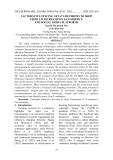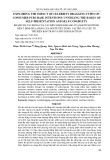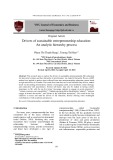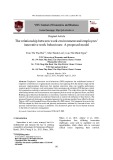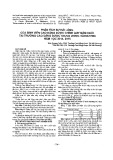
http://www.iaeme.com/IJM/index.asp 59 editor@iaeme.com
International Journal of Management (IJM)
Volume 6, Issue 12, Dec 2015, pp. 59-70, Article ID: IJM_06_12_006
Available online at
http://www.iaeme.com/IJM/issues.asp?JType=IJM&VType=6&IType=12
ISSN Print: 0976-6502 and ISSN Online: 0976-6510
© IAEME Publication
___________________________________________________________________________
ASSESSING THE PATIENT CARE
EXPENSES AND COST PER BED OF A
MEDICAL INTENSIVE CARE UNIT (MICU)
OF A TERTIARY CARE TEACHING
HOSPITAL USING COST BLOCK METHOD
Kanakavalli K. Kundury, Mamatha H. K and Divya Rao
Lecturer, Department of Health System Management Studies, JSS University,
Mysuru-570015, Karnataka
Mamatha H. K
Coordinator, Department of Health System Management Studies, JSS University,
Mysuru-570015, Karnataka
ABSTRACT
Health care, an organized provision of medical care to individuals or a
community, is one of the most important aspects of providing quality services
to the needy individuals. Cost of healthcare depends on (a) Disease condition;
(b) Coverage by insurance; (c) Medical service provider; and (d) Healthcare
infrastructure. Patients in need of critical medical care and continuous
monitoring by specialized staff are treated under specific areas of hospital
called Intensive Care Units (ICUs), which have been known to consume ~34%
of hospital budgets. The present study thus focuses on identifying major cost
drivers of MICU of a tertiary care teaching hospital. The aim of the study is to
identify various patient care expenses in MICU, find out various cost drivers
that contribute to the running cost of MICU and compute the cost per bed. A
cost block method of costing was applied in identifying the costs, and the
annual cost of services were divided into per month and per day costs. The
study found that the construction cost was the major cost drive with 50%
contribution to the overall patient care expenses per day. Laboratory costs
stood as the second major cost driver with 27% contribution. Running cost
and cost per bed were reasonable when compared with the previous studies
conducted on similar grounds.
Key words: Cost Block Method, Cost Per Bed, ICU Costing, Patient Care
Expenses, Running Cost In ICU

Kanakavalli K. Kundury, Mamatha H. K and Divya Rao
http://www.iaeme.com/IJM/index.asp 60 editor@iaeme.com
Cite this Article: Kanakavalli K. Kundury, Mamatha H. K and Divya Rao.
Assessing The Patient Care expenses and Cost Per Bed of A Medical Intensive
Care Unit (MICU) of A Tertiary Care Teaching Hospital Using Cost Block
Method. International Journal of Management, 6(12), 2015, pp. 59-70.
http://www.iaeme.com/IJM/issues.asp?JType=IJM&VType=6&IType=12
1. INTRODUCTION
1.1. Healthcare
According to Oxford dictionary of English, “Healthcare is the organized provision of
medical care provided to individuals or a community”. It not only merely includes
medical care but also all aspects of pro preventive care. Healthcare in its essential
core, is vastly recognized by a nation for public good (1). Healthcare is a public right,
and it is the responsibility of government of a nation to provide this care to all people
in equal measure(2). The economic health of a country depends first and foremost on
the physical health of its people (3). Strategies such as Health for All and Millennium
Development Goals proposed by WHO reflects the initiatives taken worldwide
towards the betterment of health conditions prevailing in developing and under
developed countries. The concept of healthcare extends way beyond the concept of
medical care(2). Awareness about diseases and preventive medicines are now given
priorities over curative medicines, which is evident with the establishment of
healthcare institutes such as wellness clinics
1.2. Cost of Healthcare
Cost of healthcare depends on various modalities such as patients disease condition,
coverage by insurance, medical service provider, healthcare infrastructure and
institutional healthcare amenities provided to the patient(4). Distributive justice and
quality in healthcare services are still finding its way difficult to reach a common
man. There is still a clear distinction in rural urban division especially in terms of
healthcare services. Also, the rising cost of these services, clearly make quality health
unaffordable for an individual/ family. According to WHO, 70% of Indians continue
to pay out of pocket for their medical expense, still failing to get access to quality
medicines and facilities. The National Sample Survey Office (NSSO) reports an
increase of healthcare expenditure from 6.6% to 6.9% in rural India and 5.2% to 5.5%
in urban areas during the period 2004-05 and 2011-12. Health Research Institute
(HRI) estimates the medical costs to rise upto 6.8% in the current year from 6.5% in
2014 (5).
The healthcare spending per capita per annum in India was about $109, with total
healthcare spending as 4.9% of the country’s GDP. The private sector contributes to
the major portion with public sector spends to a mere $19 per capita per annum(4).
Though Indian GDP contribution on healthcare in current scenario has increased than
past, there are still lacunae in the system such as economic disparities, poor healthcare
infrastructures, illiteracy and shortage of qualified medical professionals(6).
1.3. Healthcare – Hospitals and Role of Intensive Care Units
According to World Health Organization, hospital is an integral part of a social and
medical organization, the function of which is to provide for the population complete
healthcare, both curative and preventive and whose outpatients services reach out to
the family and its home environment; the hospital is also a centre for the training of

Assessing The Patient Care expenses and Cost Per Bed of A Medical Intensive Care Unit
(MICU) of A Tertiary Care Teaching Hospital Using Cost Block Method
http://www.iaeme.com/IJM/index.asp 61 editor@iaeme.com
health workers and for biosocial research (7). Among various specialty units in the
hospital, Intensive Care Units (ICUs) play vital roles in treating critically ill patients.
An intensive care unit (ICU) is a specially staffed, specially equipped, separate
section of a hospital dedicated to the observation, care and treatment of patients with
life threatening illnesses, injuries or complications from which recovery is possible. It
provides special expertise and facilities for the support of vital functions of patients
and utilizes the skill of medical, nursing and other para-medical staff experienced in
the management of patient care(8). In definition, Intensive Care Units (ICUs) are
“specific area of the hospital where sophisticated monitoring, titrated life support,
specific therapy and specialized nursing, can be best provided for potentially
salvageable critically ill patients with life threatening illness or injury” ( 9).
1.4. Cost of intensive Care Services
India being a rapidly developing country dominated with lower middle-income group
of population, intensive care services are expensive to be afforded and often a
challenge to the socio-economic status of the population(10). Private hospitals in
India contribute to majority of critical care beds, where as only 10% of ICU beds
contribute to the intensive care services in public hospitals that offer either free or
subsidized services to its patients(10). While availing critical care services, more than
half of the total health care bill is paid as out of pocket by patients or their families,
thus getting exhausted with their savings. In the absence of comprehensive health
insurance coverage, more than 80% patients have to pay out of their pockets for
healthcare services (11). Intensive care services are not only critical to severely ill
patients but also contribute largely to the bulk of medical care expenses. Critical care
services are not only a burden on patient’s side but also consumes major chunk of
hospital resources. It is an expensive area where intensive nursing and medical care
are provided round the clock. Intensive care beds account for at least 10% of the
hospital beds and 20-40% of all hospital costs. They may also consume 34% of
hospital budgets (12). It contributes to a third of total inpatient costs(13). Costing of
such critical care services identifies major factors that drive the costs and aids to
implement control measures. Thus optimizing the hospital resources and cutting down
patient care expenses. Therefore, it is important to study various aspects of ICUs for
effective resource management and efficient patient care.
2. OBJECTIVES
The objectives of the study include:
Assessing key factors that majorly influences the cost of service in Medical Intensive
Care Unit (MICU)
Computing the cost of patient care expenses and running cost
Calculate cost per bed in MICU
3. METHODOLOGY
The study was conducted at 16-bedded MICU of a tertiary care hospital, Mysuru,
Karnataka, after obtaining the consent from the concerned authorities

Kanakavalli K. Kundury, Mamatha H. K and Divya Rao
http://www.iaeme.com/IJM/index.asp 62 editor@iaeme.com
3.1. Data Collection
Data for the study was collected retrospectively by examining the hospital records
from February 2014 to March 2015; and prospectively by personal interactions with
the staff, between March 2015 and May 2015
3.2. Cost Block Method of Costing
By adopting Cost Block Methodology, costs associated with ICUs were divided in
to 6 major Cost Blocks (CB) such as CB1- Equipment costs, CB2 - Construction and
electricity costs, CB3 - Non-clinical expenses and salaries to non-clinical staff, CB4 -
Clinical services, CB5 - Consumable costs and CB6 - Salaries of clinical staff (14).
The costs were considered per year, which was further divided into per month and per
day (running cost). The cost per bed is then computed by dividing the running cost by
the total number of beds
4. RESULTS AND DISCUSSION
ICU areas of hospital are critical and expensive areas. Due to diverse case mix and
intensive patient care requirements, costing of ICUs were often considered as a
difficult task. In the current study, Cost Block Method of costing was adopted as
formulated by Edbrooke, et al., 1999. According to the method, various costs
involved in the ICU are identified under various heads as cost blocks. These cost
blocks were then studied as per various expenses involved in the patient care.
4.1 Patient Care Expenses in MICU
Figure 1 Comparison of patient care expenses in MICU
Figure 1 representing the intra-unit comparison of patient care expenses per day in
MICU. According to the figure, major cost drive in patient care expenses in MICU
was construction cost contributing to half of the total, as 50% of the charges.
Laboratory expenses stood as next highest contributor towards MICU expenses with
27%.Staff salaries including clinical and non-clinical services were found to be the
next cost drives with 7% contribution and electricity expenses with 6%, standing as

Assessing The Patient Care expenses and Cost Per Bed of A Medical Intensive Care Unit
(MICU) of A Tertiary Care Teaching Hospital Using Cost Block Method
http://www.iaeme.com/IJM/index.asp 63 editor@iaeme.com
the third highest cost drive. Consumables including stores and drug supplies have
contributed to 5% and radiology services with 4% contribution added up to patient
care expenses per day in MICU. Equipment cost, Linen and CSSD expenses were
negligible when compared to the other cost drives.
4.2. Equipment Cost: CB1
The advancements in medical field have a drastic impact on diagnostic and
therapeutic procedures, there by physician becoming equipment oriented(15).Since
ICU provides specialized care to critically ill patients, it is an equipment centric unit
that consumes more resources. It is also been observed through previous studies that
equipment costs contribute to two third and biggest contribution of the establishment
cost(16). Cost containment strategies therefore should be kept in place in order to
keep this consumption under control. Instead of procuring the equipments from other
countries, encouraging the Indian medical device market would contribute
significantly to the control of equipment costs. Re-using the instruments and
components after proper sterilization also helps in decreasing the cost of care and
maintaining optimum inventory(17). Involvement of critical care professional or
intensivist in decisions of equipment purchase with his role clearly defined also
contributes to the right selection of equipment. Thus leading to cost saving on
purchasing substandard products(10). Other options for cost saving includes pool
sharing of equipments among ICUs, hire or leasing of equipments rather than one
time huge capital investments.
In the present study, major equipments identified in MICU were ventilators-8
(Maquet), cardiac monitors- 16 (Goldway), syringe pumps – 4 (Optimars) and
infusion pumps – 4 (Optimars) along with alpha beds, nebulizers, defibrillators, ECG
machines, and X-ray view box. A total of 98 equipments were found in MICU
including cots, mattresses and cardiac tables. The total cost of equipments was
computed as Rs. 8091000, by multiplying the total number of equipment with the unit
cost of purchase. Depreciation of 10% is considered, where the cost less depreciation
was Rs. 7281900. The unit cost of equipment is thus computed as Rs 74305, by
proportionately dividing the total cost among all the equipments. A contribution of
6% equipment charges per day was shown in the study conducted by Edbrooke in
1999 (14). As the equipments in the current study were all brand new, annual
maintenance contract was already included in the package, warranty is still
operational and cost of repair was voided, resulting in lesser contribution to patient
expenses per day when compared to other cost blocks (Fig., 1)
4.3. Estate and Electricity Costs: CB2
Estate cost includes cost of land, utilities, building and engineering, maintenance and
decoration that are needed for the effective functioning of ICUs(14). In the present
study, the total area of MICU was found to be as 5441.11Sq.ft. The cost of
construction was 1.5 L per 100 Sq. ft, which includes civil, electrical and mechanical
aspects of infrastructure. The total cost of constructing MICU was Rs. 81.61 lakhs per
year and Rs. 22,671.29 per day, which is found to contribute 50% of patient care
expenses per day, standing as the major cost drive (Fig., 1).
According to the previous studies, the minimum electricity requirements per
hospital bed per day is 1KW (7). Since intensive care units are equipment dependent,
they consume more electrical power for efficient monitoring of patients round the
clock. Electricity consumption include the electrical equipment usage, lighting and

